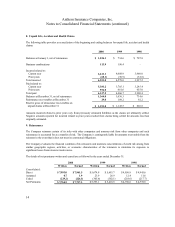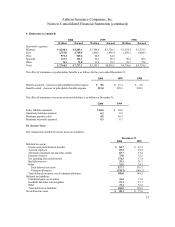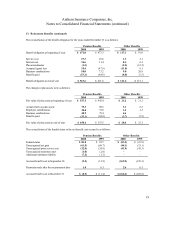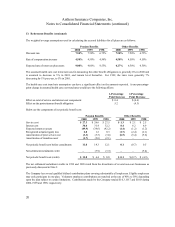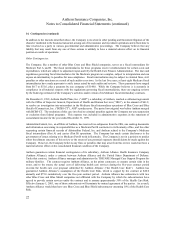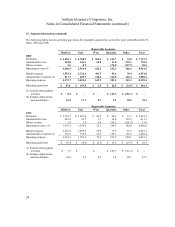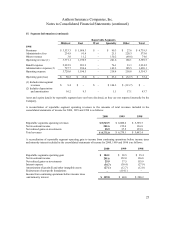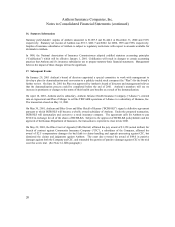Anthem Blue Cross 2000 Annual Report Download - page 25
Download and view the complete annual report
Please find page 25 of the 2000 Anthem Blue Cross annual report below. You can navigate through the pages in the report by either clicking on the pages listed below, or by using the keyword search tool below to find specific information within the annual report.23
Anthem Insurance Companies, Inc.
Notes to Consolidated Financial Statements (continued)
14. Contingencies (continued)
Vulnerability from Concentrations:
Financial instruments that potentially subject the Company to concentrations of credit risk consist primarily of
investment securities and premiums receivable. All investment securities are managed by professional investment
managers within guidelines authorized by the board of directors. Such policies limit the amounts that may be invested
in any one issuer and prescribe certain investee company criteria. Concentrations of credit risk with respect to
premiums receivable are limited due to the large number of employer groups that constitute the Company’ s customer
base in the geographic regions in which we conduct business. As of December 31, 2000, there were no significant
concentrations of financial instruments in a single investee, industry or geographic location.
15. Segment Information
The Company’ s principal reportable segments are strategic business units primarily delineated by geographic areas that
essentially offer similar insurance products and services. They are managed separately because each geographic region
has unique market, regulatory and healthcare delivery characteristics. The geographic regions are: the Midwest region,
which operates primarily in Indiana, Kentucky and Ohio; the East region, which operates primarily in Connecticut, New
Hampshire and Maine; and the West region, which operates in Colorado and Nevada. BCBS-NH was added to the East
region effective with its October 27, 1999 acquisition, while the West region was established following the acquisition
of BCBS-CO/NV on November 16, 1999. BCBS-ME is included in the East segment since its acquisition date of June
5, 2000.
In addition to its three principal reportable geographic segments, the Company operates a Specialty segment which
includes business units providing group life insurance benefits, pharmacy benefit management and third party
occupational health and dental administration services. Various ancillary business units (reported with the Other
segment) consist primarily of AdminaStar Federal which administers Medicare programs in Indiana, Illinois,
Kentucky and Ohio and Anthem Alliance which provides health care benefits and administration in nine states for
the Department of Defense’ s TRICARE Program for military families. The Other segment also includes
intersegment revenue and expense eliminations and corporate expenses not allocated to reportable segments.
Through its participation in the Federal Employee Program (“FEP”), Medicare, Medicare at Risk, and TRICARE
Program, the Company generated approximately 22%, 23%, and 22% of its total consolidated revenues from
agencies of the U.S. government for the years ended December 31, 2000, 1999, and 1998, respectively.
The Company defines operating revenues to include premium income, administrative fees and other revenues.
Operating revenues are derived from premiums and fees received primarily from the sale and administration of
health benefit products. Operating expenses are comprised of benefit and administrative expenses. The Company
calculates operating gain or loss as operating revenue less operating expenses.
The accounting policies of the segments are the same as those described in the summary of significant accounting
policies except that pension and postretirement benefit costs for each segment are recognized on a per associate per
month charge, which in aggregate approximates the consolidated expense. Any difference between the per associate
per month charge and actual consolidated expense is included in corporate expenses not allocated to reportable
segments. Intersegment sales and expenses are recorded at cost, and eliminated in the consolidated financial
statements. The Company evaluates performance of the reportable segments based on operating gain or loss as
defined above. The Company evaluates investment income, interest expense, amortization expense and income
taxes, and asset and liability details on a consolidated basis as these items are managed in a corporate shared service
environment and are not the responsibility of segment operating management.



